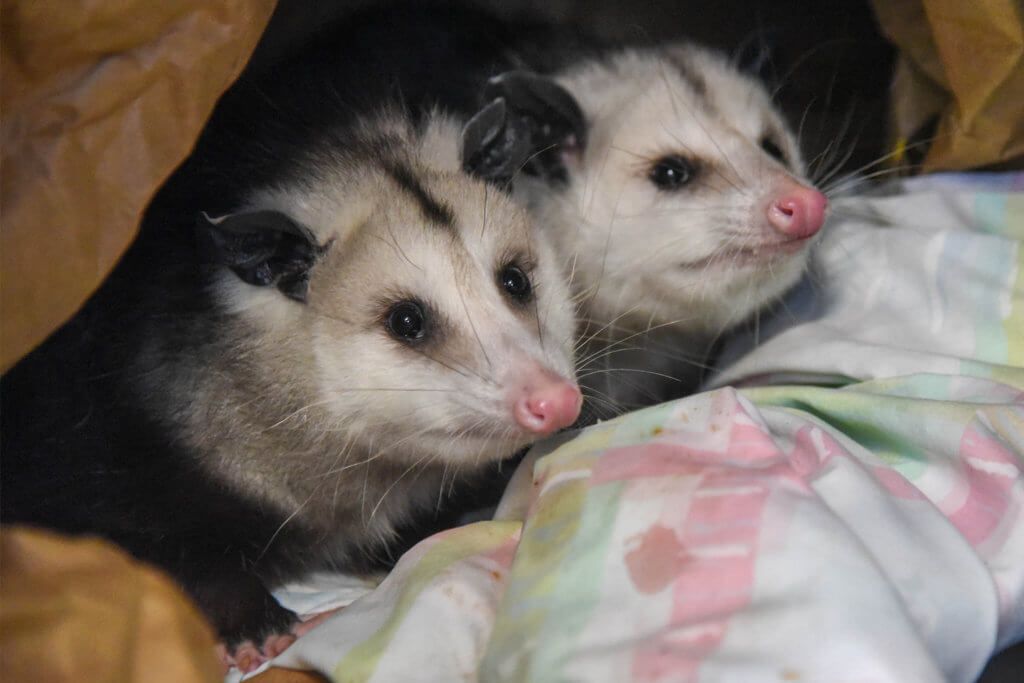Overview
“Where I live”
Opossums aren’t picky about their living conditions. Scattered across the central and eastern United States and all the way down to Costa Rica, they have a very large range. They can survive nearly anywhere within that range, from wetlands to cities, across both urban and rural areas.
“How I live there”
Opossums are nocturnal and do not commence their nightly activities until dusk. They carry on until dawn, covering extensive amounts of land. While they are primarily terrestrial, opossums are known to climb trees to find a den for the day. Opossums can acclimate very easily to human-altered environments, raiding trash for food items of any kind.
“Making my mark”
The opossum’s body is primarily gray with white hair near the skull. Its tail is prehensile, meaning it can grasp like a hand. The opossum has the most teeth–50–of any mammal in the United States.
“What eats me”
Opossums are primarily hunted by owls, coyotes, foxes, and bobcats. Large snakes will also try to hunt opossum, but opossums are unaffected by the toxins of most venomous snakes. Their well-known defense, particularly when young, is to “play dead.” When threatened, they may also bare their teeth, hiss, and try to flee.
Raising Young
As with other marsupials, the young of opossums are born underdeveloped after a relatively short gestation, and after birth they migrate to the mother’s pouch to continue their development. Up to 25 young may be born in one litter, but most of these do not survive long enough to reach the pouch to nurse. The young that do survive that journey continue development for around two months within the pouch. They will then leave the pouch and climb on the mother’s back, clinging to her as she travels. Within three to four months after birth, they leave their mother’s protection altogether.
Taxonomy
- Kingdom: Animalia
- Phylum: Chordata
- Subphylum: Vertebrata
- Class: Mammalia
- Order: Didelphimorphia
- Family: Didelphidae
- Genera: Didelphis
- Species: virginiana
What is an Animal Ambassador?
The Maryland Zoo refers to its special collection of education program animals as “Animal Ambassadors.” The Zoo currently cares for more than 60 Animal Ambassadors, representing more than 40 species, both native and exotic. These animals are managed separately from the rest of the Zoo’s collection and cannot be seen on exhibit at the Zoo. However, many can be seen up close and personal on a rotating basis at Creature Encounters, the Zoo’s outdoor education center; at camp and school programs at the Zoo; as featured participants in community-based Outreach programs; and at special events on and off Zoo grounds.
Animal Ambassadors spend countless hours working with their human handlers, developing bonds of trust and communication that will allow them to appear in front of audiences large and small. They are not show animals. They behave naturally, focusing audiences’ attention on their natural behaviors and adaptations and giving living, breathing meaning to concepts and topics that students may be studying.
Animal Ambassadors travel all over the state of Maryland and beyond, and many also make local and national media appearances, educating about wildlife while representing the Zoo and its commitments to animal welfare and conservation.
What is The Animal Embassy?
The Animal Embassy at The Maryland Zoo is an off-exhibit area that is not open to the public. It is where the Zoo’s “Animal Ambassadors,” or education program animals, live. The Embassy is home to more than 60 individual animals representing more than 40 different species. It is staffed by its own dedicated group of keepers and volunteers and has both indoor and outdoor living space for the animals.

